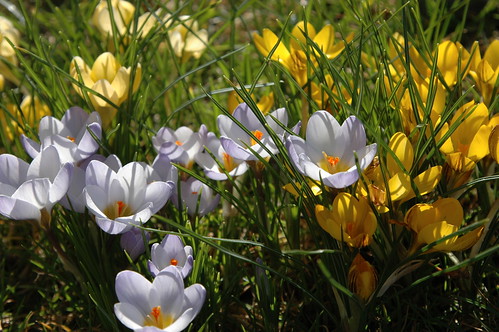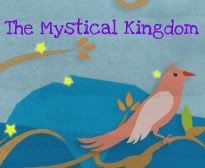"Spring, the most welcome of seasons, comes yet very slowly. The spell of winter is hard to shake off. Catkins seem in no hurry to lengthen, a new shoot passes through a clod of earth but lingers, reluctant to rise in the cold air. As the days grow longer and the breeze softens, we patiently wait and hope. The stony ground realizes, the ditches gurgle with the spring rains, and juicy buds swell on the twig. Suddenly comes the surprise of a warm day, and with it the urgent activity of growth. Beneath our feet the ground turns lush, the hedges fatten in a haze of green, and a hungry bee flies past. Nature springs effortlessly into creative action; the birds sing praise in concert."

May Day (May 1st) is celebrated in many places around the world. The traditions and stories surrounding May Day vary from place to place. There is, however, one thing that is similar in most celebrations - the use of Flowers!
A popular activity on May Day is to decorate a pole with brightly colored ribbon or paper streamers. Some also add flowers and balloons. The pole is usually carried in a parade and then placed in the ground at a designated area. People then dance around the May pole, holding the ends of the streamers or ribbon in their hands.

Miniature Maypoles for May Day
| small glass or clay gardening pots (large if making a centerpiece) | |
| gold or brown sprayed florist's picks | |
| three shades of narrow ribbon | |
| glue gun & stick | |
| potpourri or potting soil if using potting soil, moss small flower or rosebud to affix to top Make the poles by getting out all of your items. Wrap the florist's pick (pole) with the three shades of ribbon, weaving through in the traditional "around the Maypole" fashion. Tie the ribbon into a bow at the top and affix the rosebud or other small flower on top of that with the glue gun. Place the pole into the center of the pot (easier if you place a drop of the glue onto the bottom of the pole before placing it in). Then surround the pole with the potting soil and moss or the potpourri. Tie a color-coordinated ribbon around the pot and use as decoration at your nature table, dinner table or as a craft activity for the children and friends. Depending on the size of the pots and poles, we have used these as small favors at our May Fairy parties, as grand centerpieces at picnic tables and as Maypoles in our garden, inviting the fairy folk to participate in the fun. Enjoy! The Celtic year is divided into the dark and the light. Samhain begins the dark half; its counterpart, Beltane, is the beginning of the light half. Beltane and Samhain therefore divide the year into the two primary seasons, Winter and Summer. Beltane went by many names: Beltaine in Ireland, Bealtuinn in Scotland, Shenn do Boaldyn on the Isle of Man and Galan Mai in Wales. It is also referred to as Cetsamhain which means "opposite Samhain." By Celtic reckoning, the actual Beltane celebration begins on sundown of the preceding day, April 30, because the Celts figured their days from sundown to sundown. The word "Beltane" literally means "bright" or "brilliant fire," and refers to the bonfires lit to celebrate this festival. Sundown was the time when the great Bel-fires would be kindled on the tops of the nearest beacon hill (such as Tara Hill, Co. Meath, in Ireland). Cattle and sheep which had been kept inside or close to the farmsteads during the long winter months could now be turned out into the fields or led away to their summer pastures. The tribal herds were ritually driven between the bonfires, to purify and protect them in the upcoming year. Healing herbs were burnt in the fires, producing smoke which would help destroy parasites and help prevent illness among cattle, sheep and other livestock. Another popular custom was to leap over the Beltane bonfire. Young people jumped the fire for luck in finding a spouse, and pregnant women jumped the fire to assure an easy delivery. Domestic fires, which were kept alight all through the year, were extinguished on Beltane Eve and then rekindled from the great Bel-fires with torches the next morning. Even these small household fires were sacred, and Celtic Christians developed trinitarian rituals associated with tending the household fires. When fires were smothered for the night, for example, the peat blocks were divided into three equal sections and prayed for in the name of the God of Life, the God of Peace and the God of Grace. Then the whole fire was covered in ashes in the name of the Three of Light, with the following prayer: "The sacred Three to save, to shield, to surround, the hearth, the house, the household, this eve, this night, O this eve, this night, and every night, each single night. Amen." Beltane is a holiday of fires, flowers, fertility, and frivolity—celebrating the reawakening of the earth and the return of life to the world. Handfastings—binding couples together for a year and a day, were traditionally performed on this day. It was customary for young lovers to spend the night in the woods. The best known tradition associated with the day is to dance around a tree while weaving greenery around it. This dance around the May Pole, using cloths or ribbons, is still performed in many parts of the world, and is the primary Beltane ceremony that has survived to the modern era. May-Baskets by Evaleen SteinLet us take our baskets earlyTo the meadows green, While the wild-flowers still are pearly With the dewdrops' sheen. Fill them full of blossoms rosy, Violets and gay Cowslips, every pretty posy Welcoming the May. Then our lovely loads we'll carry Down the village street, On each door, with laughter merry, Hang a basket sweet. Hey-a-day-day! It is spring now, Lazy folks, awake! See the pretty things we bring now For the May-day's sake! |








Your newest follower :)
ReplyDeleteHey Denise thank for following :)
ReplyDeletecute little stacking blocks
ReplyDelete